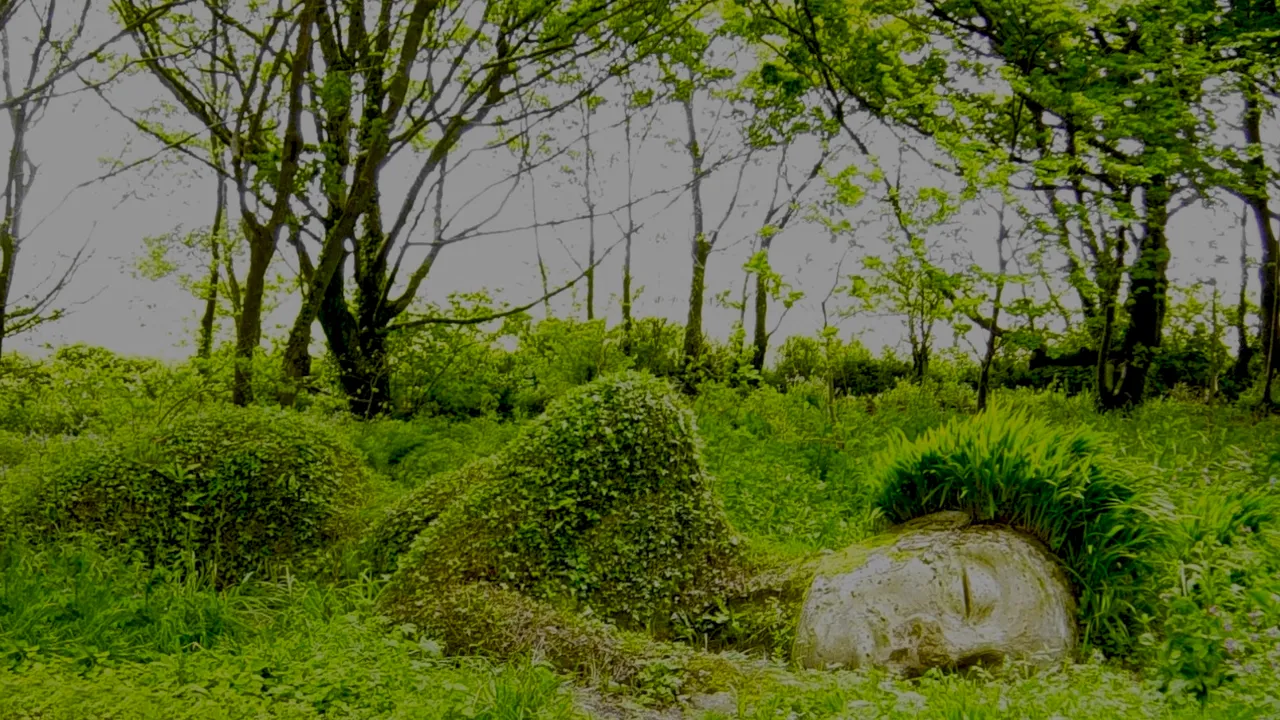feeding fertile hallowed earth
the giantess breathes.

The Mud Maid is a living sculpture by Sue Hill at The Lost Gardens of Heligan, Cornwall, UK.
Depending on the season, the mud maid’s ‘hair’ and ‘clothes’ change when the seasonal plants and moss grow over the sculpture.
I love the style of this sculpture and the associations with Britain's mythic past of giants.
Although the sculptor says that the original idea was meant to be a mermaid who had wandered from the sea and fallen asleep in the woods, for me the Mud Maid epitomises the legends of sleeping giants making up the hills and valleys of the UK.
In Anglo-Saxon mythology and pagan belief the giants (or Jotunn as they were known in the Norse mythology) vied with the gods for supremacy of the lands before the time of humans. The giants (known as the Eddas in Germanic tradition) are described in fables as ancestors to the gods, but also their enemies and as powerful as the gods. Although often outwitted by various gods in fables, the giants remain a cunning and unrelenting force to be reckoned with. They represented the powers of untamed wilderness, and perhaps this is why we see them return to the landscape in death.
Anglo-Saxon paganism was a polytheistic belief system, focused around a belief in deities known as the ése. The most prominent of these deities was probably Woden; other prominent gods included Thunor and Tiw. Many of the gods of ancient Britain mirror the Norse traditions; Woden/Odin and Thunor/Thor, as do many of the creation myths.
Many landmarks of Albion (the ancient name for the British Isles) are attributed to the giants in ancient folklore who were often portrayed as builders and creators. According to Geoffrey of Monmouth’s 12th-century History of the Kings of Britain, Stonehenge was originally brought from Africa to Mount Killaurus in Ireland by giants. Its magical stones had healing properties, and the giants built a bathhouse amid the stones to cure illness.
We find a similar story in Yorkshire. On Wheeldale Moor there is a mile-long stretch of ancient road that snakes across the moorland, probably Roman but perhaps even earlier. The striking monument is also known as Wade’s Causeway, after a giant named Wade (or ‘Wada’ in Old English). It is said that Wade built the causeway with his wife Bell, so that she could milk her huge cow on the moors; the boulders scattered across the landscape are said to have fallen from her apron as she went about building the road.
Regardless of the truth behind the origins of the mythology of giants across the world, they have permeated our subconscious providing a powerful archetype for many tales of fantasy and heroism. As a writer of fantasy fiction these legends provide a powerful wellspring of creativity to draw upon, delving into them puts me into a place of inspiration and healing similar to the legendary bathhouses of Stonehenge.
Thanks for reading.
The image used in this post is creative commons licence, linked to credit beneath the picture. If you have enjoyed this Haiku, please check out my other work on my homepage @raj808.


 Click banner to visit the community page
Click banner to visit the community page
 Find us on twitter by clicking the banner above.
Find us on twitter by clicking the banner above.
Interested in trading, buying or selling crypto?
Sign up to Bittrex here.
Sign up to Coinbase here.
Sign up to Swissborg app to instantly buy crypto here.
Use my referral link to sign up for Crypto.com and we both get $25 USD.
If You Have Found Value From this Post and Want to tip extra, Crypto Donations Are Welcomed:
►Donate Ether and ERC20 Tokens: 0x32321615174AF3Da6074Cf79DED8269cA7a8eB24
►Donate Bitcoin: bc1q8wutj8u6ush7s8mucphfxf7gzrexeywmuqm8g3
►Donate Bitcoin Cash: qzt7c0czw0q988h93jvcz2rq5gy0s3h9pg2pk700ev
►Donate Litecoin: Lfsnz3pbT5V9N6WWGRaBsgKs9EvFeqzcPm
►Donate BNB: bnb1xeu94exteel9w3g8g44e6g595kvrqlgzm0crq4
►Donate Monero: 49PovXGcM9Y7JYeRJ35W9xZGrdivvLaMbVtGc3WDv6amCm5wqA854SvJNWxaEqjTz18K5YVPj5D6619C3bvNHsrG7oD1whb
►Donate Tezos: tz1SJUkpeznKE6bEhbX81YFdUQS5BprA4ot8
►Donate XRP: r35quYTThThN7yNvkJxyhLFAPyju3tsT35
